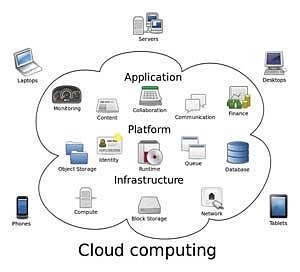June 2017 - The Buzz about Cloud Computing
June 20th, 2017 The buzz about cloud computing?
The buzz about cloud computing?The internet has spawned an absolute deluge of technical talk with 'the Cloud' being touted as an answer for companies that want to distribute their products and services to as wide a footprint as possible.
So what, in broad terms, is 'the Cloud'?
For starters there is no actual 'cloud' it's a euphemism for the internet. As a definition, Cloud (computing) is a distributed system that mainly focuses on providing, via the internet, a wide range of resources that could be computational, data storage, application delivery etc to users.
Because the user is unable to 'see' the units that provide the resources, these are known as virtual machines and may be deployed singularly or as a collection of workstations (COWS) to run tasks concurrntly. The Cloud is thus able to provide considerable computational power that has, however, to be efficiently scheduled so as to optimise the available resources.
Scheduling or load balancing is a means of dividing the task, to be done, between computers, processors or other resources effectively so as to minimise response time, simultaneously reducing a condition that may lead to overloading some nodes and not others.
Implementing effective load balancing is able to transfer an above threshold load condition to another below threshold load virtual machine resulting in improved efficiencies and user experience.
To achieve this desired option, attention was given to honey bee foraging behaviour.
Honey bees are very opportunistic. They seemingly are very structured at their tasks and this is certainly so within the confines of the hive where the just emerged young growing bee begins right at the bottom rung of the bee ladder attending to the many chores needed in the hive.
The fully adult bee moves up the chore rungs to finally begin the last task of its short life namely foraging for nectar and pollen needed to feed the swarm. Short local flights outside the hive are undertaken for orientation.
These flights also incorporate the messages given by the waggle dance that signals where and how far to a food resource and so the flight lengths increase with some, if the resource warrants, extending to kilometres each way.
Food sources are found by scout bees who then return, do the waggle dance and provide samples to foragers who will determine whether the new source is preferable to their current source which, if it is, will be exploited until depletion and abandoned. A new food source is randomly determined by a scout bee who will return with this information.
By observing honey bees electronically it was determined that foraging employs decentralised load (food source) balancing and transfer of tasks (scout returns with new source information) on the fly.
Collected foraging pattern data was used to build an artificial bee colony algorithm (ABC) now used to optimise load balancing of tasks that reduces the idle time of virtual machines and increases their productivity for the same cost.
Comments (0)
No comments have been submitted yet.Why not be the first to send us your thoughts
Leave A Comment
Thank you for your comments, they will appear shortly once approved.
Recent Posts
Have You Seen...






